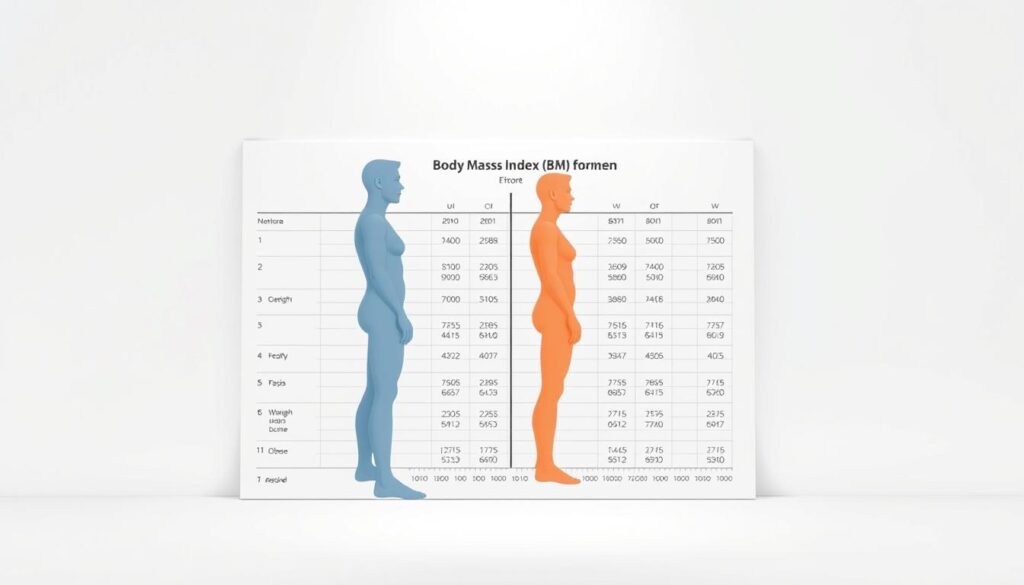How often do you measure your fitness progress using just a scale? While weight matters, it’s only part of the story. Understanding your body’s composition requires a deeper look—one that factors in both height and mass to reveal insights about your overall well-being.
Our BMI calculator for men simplifies this process. Designed for adults aged 20+, it delivers instant results using data from trusted sources like the National Center for Chronic Disease Prevention. By analyzing your height and weight, it categorizes your body mass index—a number healthcare professionals rely on to screen for potential risks.
This tool isn’t just about numbers. It’s a gateway to understanding how your current status aligns with healthy ranges. For example, results can highlight whether you’re in an optimal zone or need adjustments. We prioritize clarity, ensuring every calculation helps you make informed choices about nutrition, exercise, and long-term wellness.
Key Takeaways
- Quickly assess body composition using height and weight inputs
- Results align with standards from leading health organizations
- Designed specifically for adults over 20 years old
- Identifies potential health risks tied to body mass extremes
- User-friendly interface for immediate insights
While no single metric defines health, this calculator offers a reliable starting point. In the next sections, we’ll break down how BMI works, why it matters for men, and how to use it effectively in your fitness journey.
Understanding Body Mass Index for Men
A single number can unlock insights into your body’s relationship with potential health challenges. The body mass index evaluates weight relative to height, offering a snapshot of where you stand within standardized ranges. While not a diagnostic tool, it’s widely used by professionals to identify trends that might need attention.
Breaking Down the Formula
The calculation divides weight in kilograms by height in meters squared. For imperial measurements, multiply weight (pounds) by 703, then divide by height (inches) squared. This simple math creates a value that places individuals into four main categories recognized by the CDC:
- Under 18.5: Associated with nutrient deficiencies
- 18.5–24.9: Optimal range for most adults
- 25–29.9: Increased risk of hypertension
- 30+: Higher likelihood of type 2 diabetes
What These Numbers Mean
Men often carry more muscle mass than women, which can skew results slightly higher without indicating excess fat. However, values above 30 correlate strongly with cardiovascular strain. “BMI serves as an initial screening step, not a final verdict,” notes a NCCDPHP report. Pairing this measure with waist circumference or body fat percentage creates a clearer picture.
Remember, this index doesn’t account for bone density or muscle composition. Athletes might fall into “overweight” categories despite being fit. Use it as one piece of your health puzzle rather than the entire solution.
How Our BMI Calculator for Men Works
Gaining clarity about your physical health starts with precise measurements. Our interface requires just two inputs: your height and weight. You’ll find separate fields for feet/inches or meters, and pounds or kilograms—no confusing conversions needed.
Input Data, Formulas, and Instant Results
Here’s how it works in practice:
- Enter your details using any measurement system
- Our system automatically applies the correct formula—(weight kg / height m²) or (lbs × 703 / inches²)
- Results appear instantly with your category and personalized insights
Take a 5’10”, 160-pound individual. The tool converts this to 70 inches tall, then calculates (160 × 703) / (70 × 70) = 22.9. This falls within the optimal range, as outlined in adult body mass evaluation standards.
We also incorporate the Ponderal Index for those with unusually high or low stature. This adjustment ensures accuracy across all body types. Muscle mass variations are acknowledged in our analysis, though we recommend pairing results with body fat measurements for athletic builds.
Every calculation uses peer-reviewed formulas to deliver reliable health insights. Whether you’re tracking progress or assessing risks, our tool transforms raw numbers into actionable information—instantly.
Integrating BMI Insights Into Your Health Journey
Your health journey thrives on multiple data points working together. While numbers from our body mass index calculator provide direction, combining them with other metrics creates a roadmap for sustainable progress.
Connecting Metrics to Health Outcomes
Higher body mass index values correlate with specific risks. The CDC reports that adults above 25 face:
| BMI Range | Associated Risks | Recommended Actions |
|---|---|---|
| 25–29.9 | 27% higher type 2 diabetes risk | Increase physical activity |
| 30+ | 40% increased heart disease likelihood | Consult healthcare providers |
Muscle mass and waist measurements refine these insights. A study by the NCCDPHP found individuals with healthy BMI but large waistlines (over 40 inches for men) still face elevated health risks.
Building a Complete Health Profile
Pair your results with these steps:
- Track waist circumference monthly
- Measure body fat percentage annually
- Discuss family history with your doctor
“Health assessments should always consider multiple indicators – no single number tells the full story.”
Our weight management guide offers science-backed strategies to improve body composition. Whether adjusting nutrition or exercise routines, small changes create lasting impacts when guided by reliable data.
Conclusion
Taking charge of your well-being starts with understanding your body’s unique needs. Our tool provides instant health insights by analyzing height and weight against trusted standards. Results reveal where you stand across four key categories—from optimal ranges to elevated risk zones for conditions like diabetes and heart disease.
Remember, numbers alone don’t define health. Pair your reading with waist measurements or body fat checks for a complete picture. Athletes with higher muscle mass might see skewed results, while those with healthy weights but large waistlines still face risks.
We’ve designed this resource using CDC-approved formulas to ensure accuracy. It’s more than a snapshot—it’s a springboard for informed choices about nutrition, fitness, and long-term wellness. Share it with friends or family members to help them assess their status too.
Ready to take action? Use our tool today, then discuss your results with a healthcare provider. Combine this data with regular checkups and lifestyle adjustments to build a stronger, healthier future—one smart decision at a time.



